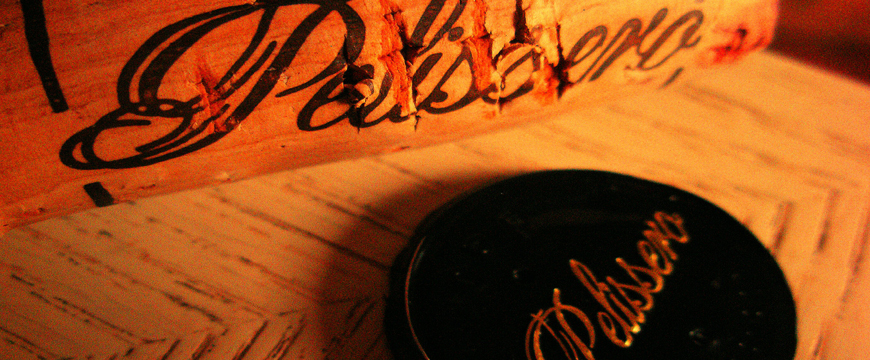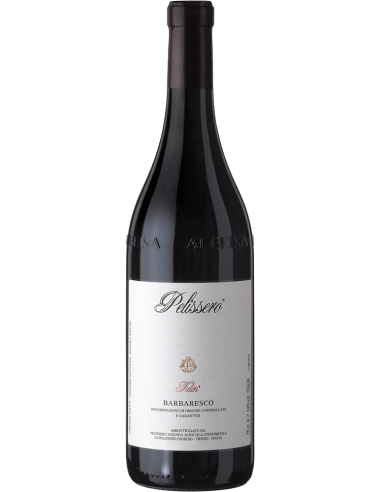-
All products
TypeWineriesItalyRest of the WorldGreat Wines
- Barolo and its Crus
- Bolgheri
- Bordeaux and the French Bordelais
- Brunello di Montalcino iconic
- Chianti ancient tradition
- Supertuscan the Italian Bordeaux blend
- Syrah Millenary Tradition
- Great International Red Wines
- Great International White Wines
- Amarone in all its elegance
- Pinot Noir from the World
- Timorasso a jewel to discover
-
PROMOTIONS
Promotions
-
Red Wines
ITALY Top Selection Red WinesWORLD Top Selection Red Wines
-
White Wines
ITALY Top Selection White WinesWORLD Top Selection White Wines
-
Rosé Wines
ITALY Top Selection Rosè Wines
-
Bubbles
ChampagneItalian Sparkling WinesEnglish Sparkling Wines
-
Special Wines
Flavoured WinesWines in Amphora
-
Wines to Discover
Rares & AwardedBrands & MakersOrganic & Heroic
-
Distillates
Whiskey
- Cantine
- Blog
'Tulin' is the name with which since 2001 Pelissero has decided to identify the previous Barbaresco that until then was nameless. We have attributed to this wine the name of the vineyard from which the grapes come, in order to give it an identity enhanced by a soil whose microclimate and exposure constitute a site of undeniable quality. In Piedmontese dialect, Tulin refers to a small round tin container, concave and carved, used for two purposes: in churches as a means of collecting the wax that drips from the candlesticks and in stables as a tool for distributing feed to livestock. Spirituality and practicality, the soul and hands of the winemakers. Tulin is pronounced with the accent on the i.
- Product Category
- Red Wine
- Denomination
- Barbaresco DOCG
- Grape variety / Raw material
- Nebbiolo
- Vintage or Cuvée
- 2017
- Format
- 750 ml.
- Nation
- Italy
- Region
- Piedmont
- Alcohol Content
- 14.5% vol.
- Operating Temperature
- 18° - 20° C.
- Recommended Glass
- Wide goblet with a long stem
- Gastronomic Pairings
- Aged Cheeses, Game (as in wild game or hunted animals), Red Meats
- Allergens
- Contains sulfites (sulfites refer to sulfur dioxide that is added to wine to preserve it, thanks to its disinfectant, antioxidant, and stabilizing action)
Pelissero

In the heart of the Langhe, a corner of Piedmont that has enchanted for centuries with its beauty and legendary wines, lies the winery Pelissero. This family-run establishment is a tribute to tradition and a passion for wine, passed down from generation to generation. Nestled among the hills that create a landscape of extraordinary harmony, Pelissero is dedicated to producing wines that celebrate the territory, with meticulous attention to detail and respect for the vineyard.
Specializing in the great reds of the Langhe, Pelissero is synonymous with Barbaresco, a wine that embodies the elegance and complexity of Nebbiolo, the queen grape of these lands. Alongside Nebbiolo, the vineyards of Pelissero also include Barbera and Dolcetto, varieties that enrich the wine landscape of this winery with wines that express character and authenticity.
Every bottle signed by Pelissero is an invitation to discover the nuances of the territory, through wines that combine structure and finesse, with aromas that slowly reveal themselves to the nose and palate. The Barbaresco, in particular, stands out for its ability to tell stories of terroir, vintages, and skilled hands that have tended to every detail, from the vineyard to the winery.
Let yourself be seduced by the labels of Pelissero on Vino45, a journey through the timeless charm of the Langhe and the artisanal mastery of a family that has made wine their reason for living.
Address:
Via Ferrere,19 - 12050 Treiso (CN), Italy
Color: ruby red
Bouquet: broad aromas of magnesium and iron linked to the minerality of the soil, fruity with clearly evident varietal notes and a proper contribution of wood
Taste: the typical austerity characteristics of Nebbiolo are fully expressed, where smoothness, sapidity, and the right tannin provide a velvety and enveloping sensation in the mouth.
- Vinous 94/100
- Vini Buoni d'Italia 4 stars - excellent
- I Vini di Veronelli 3 stars - excellent
- Terroir Sense 93/100

There are no reviews
Reviews

THE WINE
'Tulin'It is the name with which since 2001Pelissero"has decided to identify the previous one." Barbaresco until then nameless. We have given this wine the name of the vineyard from which the grapes come, in order to confer an identity enhanced by a land whose microclimate and exposure constitute a site of undeniable value. In Piedmontese dialect, Tulin refers to a small round container made of concave and carved tin, used for two purposes: in churches as a means of collecting the wax that drips from the candlesticks, and in stables as a tool for distributing feed to livestock. Spirituality and practicality, the soul and the hands of the winemakers. Tulin is pronounced with the accent on the "i."
Our desire to bottle the characteristics of the grape influences all the transformation and aging processes. This wine is produced using modern techniques and tools, but still in a traditional way, trying to harmonize the austerity of this great grape variety with the new concepts of smoothness and pleasantness related to international tastes. Maceration in contact with the skins for about 15 days in temperature-controlled steel tanks, and after a period of natural decantation also in steel, the nearly finished wine is transferred to wood where it rests for 18 to 20 months. Then, the portion aged in 50 Hl oak barrels is blended, with the remaining portion aged in barriques. This allows us to avoid excessive wood presence that would further dry out this wine. Another nine months in the bottle, and then it is released on the market.
THE FARMHOUSE
Cascina Tolino (Tulin in Piedmontese) was purchased by our company in two stages: the first part in 1999 and the second in 2004. The name Tulin is likely linked to the person who once lived in this land. In Piedmontese dialect, the word Tulin means small tin container, and the "tulé" was the tinsmith, the one who worked with tin.
The vineyard is a plot of 12 hectares entirely planted with Nebbiolo (in the subzone called San Stefanetto), Barbera and to a lesser extent Dolcetto. It is a single body, almost an entire hill, with an altitude ranging from 250 to 400 meters above sea level. Within it are three old farmhouses, and it presents itself as a natural amphitheater facing south/southeast on a particularly steep hill. Geologically, our territory is attributed to two different epochs of origin, characterized by hills of varying steepness. The steeper ones like this generally have harder and more compact soil, with a very thin surface layer prone to erosion. These characteristics result in very austere, tannic wines, rich in structure and mineral aromas, considered classic for the production of Nebbiolo. Geographically, the property is divided between two municipalities; the southeastern part is located in the Municipality of Neviglie, while the southern part is in the municipality of Treiso. The boundaries are not visible without topographic instruments, and the pedoclimatic characteristics are similar, but for legislative reasons, only the Nebbiolo in the portion of Treiso can become... Barbaresco And for this reason, the Nebbiolo planted in the Municipality of Neviglie is used to produce our Langhe doc Long Now. This limitation comes from a lack of vision from past administrators who would probably realize, in hindsight, the enormous mistake they made. Indeed, as early as the late 1800s, one of the most important manuscripts on the history of our denominations (recently reprinted by the Knights of the Truffle and the Wines of Alba) already addressed this issue.
It is the "Monograph on Viticulture and Oenology in the Province of Cuneo" written by Lorenzo Fantini, which states: "…the only thing that legitimizes the distinction of the area is the excellence and delicacy of the product. It is limited to the pure and simple territory of the municipality of..." Barbaresco, ", leaving out rather a small segment to the south and a small part of the common boundary with Neviglie. It has the shape of a spindle whose ends are almost pointed in the direction of the poles...".
Clearly, at the time there was no reference to the municipality of Treiso as it was, until 1957, a fraction of the municipality of Barbaresco. The history also helps to highlight the strong wine-growing vocation of this beautiful hill.
THE COMPANY
Our family has always been dedicated to agriculture with Langhe and farming DNA. We are in Treiso, an independent municipality from Barbaresco since 1957, in the heart of the production area of one of the first DOCG Italian, the Barbaresco, son of King Nebbiolo, the variety that more than any other has shaped and will continue to shape the history of our hills and of national and international winemaking. We are children of this land and of this grape variety.
The spirit of continuous research, both in the vineyard and then in the winery, along with passion, commitment, and innovative dynamism are our constants that come together with the pride of having now reached the third generation of grape growers. However, the philosophy has not changed: only native varieties typical of our lands, particularly Nebbiolo, Barbera, and Dolcetto, which account for 85% of our production. All the grapes we use come from the 38 hectares of owned land, and we are able, with the help of skilled collaborators, to directly oversee the entire production cycle, from pruning to the marketing of the 250,000 bottles produced annually. Pelissero, But if you prefer to get to know us better, trust one of our 250,000 bottles: the Barbaresco Vanotu, the Barbaresco Tulin, the Barbaresco Nubiola, the Dolcetto (Munfrina and Augenta), the Barbera Piani, the Barbera Tulin Reserve, the Nebbiolo, the Long Now, the Freisa, the Favorita, and the Moscato will tell you about the physical and chemical characteristics of the 38 hectares that we cultivate just a stone's throw from Alba, in the municipalities of Treiso, Neive, , Barbaresco and Neviglie; and about the characteristics of the three main grape varieties that we have been harvesting for two generations, Nebbiolo, Barbera, and Dolcetto. They will speak to you in straightforward Piedmontese, with a background of the Balkans, Norway, North Africa, and Japan.









